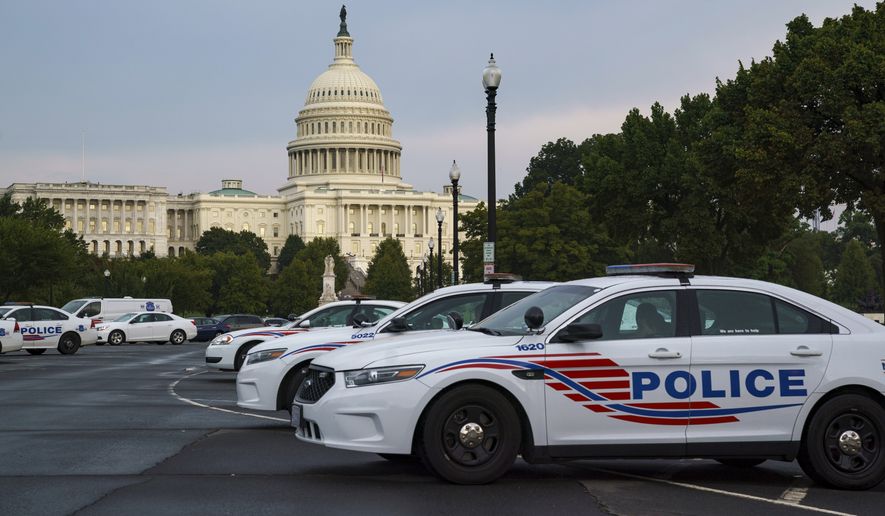Five people were shot, one fatally, at a hotel Thursday in the nation’s capital. On Monday, three people were gunned down in separate shootings in Chicago. The previous day, six people were found shot to death at a home in Milwaukee.
These major cities reported the deadly shootings as a national police union warned that an uptick in homicides across the country over the past two years will carry over into 2022 if a wave of anti-police rhetoric continues.
FBI statistics show that homicides jumped by nearly 30% in 2020 compared with 2019, from 16,669 to 21,570, and a report released this week shows that the trend worsened in 2021.
The Council on Criminal Justice report shows that the number of homicides in 22 major cities — including Chicago, the District of Columbia and Milwaukee — was 5% higher last year than in 2020, with 218 more homicides, and 44% higher than in 2019, with 1,298 more homicides.
Sgt. Betsy Brantner Smith, a spokeswoman for the National Police Association, told The Washington Times this week that she believes the rise in killings is directly linked to hostility toward police.
“I do believe that homicide rates will continue to increase as long as the vilification of law enforcement continues,” Ms. Brantner Smith said.
SEE ALSO: AOC’s Republican challenger backs death penalty for police murders
The police association, she said, is “hopeful” that Americans recognize “that the police are not the problem; criminals, bail reform and lax prosecutions are.”
Richard Rosenfeld, a co-author of the report and member of the council, told The Times that the “homicide increase slowed from 2020 to 2021 and may continue to subside in the coming year.”
“But much will depend on conditions that are hard to predict: a renewed pandemic, another police killing that goes viral and spurs social unrest, continuing increases in inflation,” Mr. Rosenfeld said. “No one predicted the unprecedented homicide increase of 2020, and there is no crystal ball telling us what 2022 will bring.”
The Council on Criminal Justice bills itself as a nonpartisan Washington-based think tank and membership organization that “works to advance understanding of the criminal justice policy choices facing the nation and build consensus for solutions that enhance safety and justice for all.”
In its report, the council noted that the homicide numbers are significantly lower than the nationwide historical peaks of the 1990s, but the surge in some cities has been staggering.
St. Petersburg, Florida, recorded a 108% increase in homicides last year, from 24 to 50. Homicides in Austin, Texas, went up by 86%, from 43 to 80. The District reported a 16% increase, from 191 to 221.
SEE ALSO: NYC gives final salute to slain NYPD officer
“Homicide increases above and beyond normal seasonal changes remain deeply troubling and require immediate action from policymakers,” the report states.
Thomas Abt, a co-author of the report and a senior fellow for the council, said the rise in killings is “not acceptable” and that at least 10 cities “lost historic numbers of residents to murder last year.”
To curb the deadly violence, the report co-authors said, police and policymakers should pursue proven violence prevention strategies and “needed policing reforms.”
As the pandemic subsides, they said, “hot-spot” policing strategies should be redoubled in areas with high rates of violence and anti-violence efforts by non-police entities, such as street outreach workers, should be strengthened.
“These anti-crime efforts should occur in tandem with long-term reforms to increase accountability for police misconduct and to redirect certain police functions, such as addressing the day-to-day problems of the homeless and responding to drug overdoses, to other agencies and personnel that in many cases are better equipped to handle them,” the report states.
Abandoning “long-needed” changes to police functions, they said, is not a “viable policy option.”
“Rather, because collaborative relationships between police and communities are essential to achieve durable reductions in urban violence, police reforms that strengthen trust and legitimacy also are essential,” the report states.
Ms. Brantner Smith said the report “seems to focus on what police can do to stop and prevent crime.”
“I observed no mention of the ‘prosecution’ of crime, the ‘incarceration’ of criminals or the responsibility of the public to stop ‘committing’ crimes,” she said.
The retired police sergeant said the National Police Association wants to “see some focus” on who commits crime and what happens when they are caught.
“We’d like to see what effect bail reform, defunding, de-prosecution, light sentencing, and the vilification of law enforcement by activist groups, the media and politicians have on crime,” she said. “This ‘study’ seems to focus only on the police, and we can’t be the only answer to America’s crime crisis.”
A spokeswoman for the Council on Criminal Justice, however, told The Times that the “council’s leaders disagreed with that representation.”
“Both the crime analysis and earlier work make clear that police should never be expected to reduce violence on their own,” the spokeswoman said.
She added that the council released a crime reduction action earlier this month which “emphasized that collaboration and accountability for those who perpetrate violence are essential.”
• Emily Zantow can be reached at ezantow@washingtontimes.com.




Please read our comment policy before commenting.